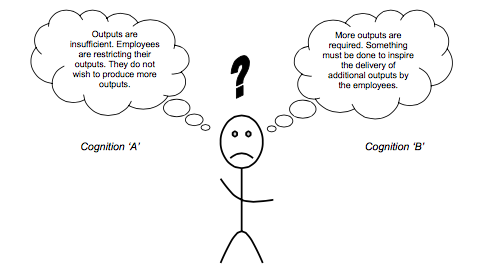Cognitive Dissonance Theory for Inspiring Social Change

By A.P.F. Gorman May 2005. Available at manasclerk.com)
The significance of cognitive dissonance needs to be understood to rationalize the theory underlying social change processes. Social change in the context described might be applied within a personal or family relationship, a work organization, or within society in general. And, the theory can be rationalized in its application in terms of scale for example in inciting the conditions for civil revolution and changing political systems of governance, or complex organizational change within multinational corporations.
Cognitive dissonance is characterized as psychological conflict resulting from incongruous beliefs and attitudes held simultaneously. This is to say that each individual and group of individuals that identify with unique and common beliefs experience psychological conflict when incompatible cognitions are presented that otherwise challenge the existing beliefs. Leon Festinger (1957) advanced the theory and observed that the relationship in respect of their compatibility and incompatibility between cognitions was significant.
In many instances there is an irrelevance between one cognition and another and this irrelevance is of no particular consequence to the extent that the individual does not distinguish an interconnected relationship between the differing yet irrelevant cognitions. On the other hand, where a newly introduced cognition challenges the conventional belief associated with a pre- existing cognition a psychological tension or conflict arises. A first and natural response may be to dismiss the newly introduced cognition in favour of the pre-existing belief. The beliefs of the individual create a context within which the individual thinks and relates the significance, and assigns meaning in response, to activities within the occurring world, and the individual will set forth to validate the existing belief with each relevant (and irrelevant) cognition. Specifically, something happens and the individual sets forth to relate it to all that he or she already knows. For example, an individual may be endeared to particular religious convictions and beliefs, or beliefs regarding the behaviour of management within a work organization and from the occurrence of something that is happening he or she assigns meaning to the activity on the basis of his or her pre-existing beliefs. The individual will set forth to derive a sense of belonging with other individuals who espouse similar beliefs, both to strengthen the belief and to derive a sense of security within a cultural similarity. The adage that there is safety in numbers applies.
What happens to individuals when they discover dissonant cognitions? The answer to this question forms the basic postulate of Festinger1s theory. A person who has dissonant or discrepant cognitions is said to be in a state of psychological dissonance, which is experienced as unpleasant psychological tension. This tension state, though it may not even be fully distinguished, has us experiencing that something is missing, or something is wrong, and we need to have it satisfied and to the extent that the tension is experienced the individual wishes to move toward a state of consonance.
To understand the alternatives open to an individual in a state of dissonance, we must first understand the factors that affect the magnitude of dissonance arousal.
-
First, in its simplest form, dissonance increases as the degree of discrepancy among cognitions increases.
-
Second, dissonance increases as the number of discrepant cognitions increases.
-
Third, dissonance is inversely proportional to the number of consonant cognitions held by an individual.
-
Fourth, the relative weights given to the consonant and dissonant cognitions may be adjusted by their importance in the mind of the individual.
If dissonance is experienced as an unpleasant drive state, the individual is motivated to reduce it. Now that the factors that affect the magnitude of this unpleasantness have been identified, it should be possible to predict what we can do to reduce it, or create it as the case may be:
Changing Congnitions
If two cognitions are discrepant, we can simply change one to make it consistent with the other. Or we can dismiss one. Or we can change each cognition in the direction of the other.
Adding cognitions
If two cognitions cause a certain magnitude of dissonance, adding one or more consonant cognitions can reduce that magnitude. We can set forth to add cognitions that serve to validate the preferred cognition, thereby reducing the weight of the undesired cognition.
Altering importance
Since the discrepant and consonant cognitions must be weighed by importance, it may be advantageous to alter the importance of the various cognitions.
